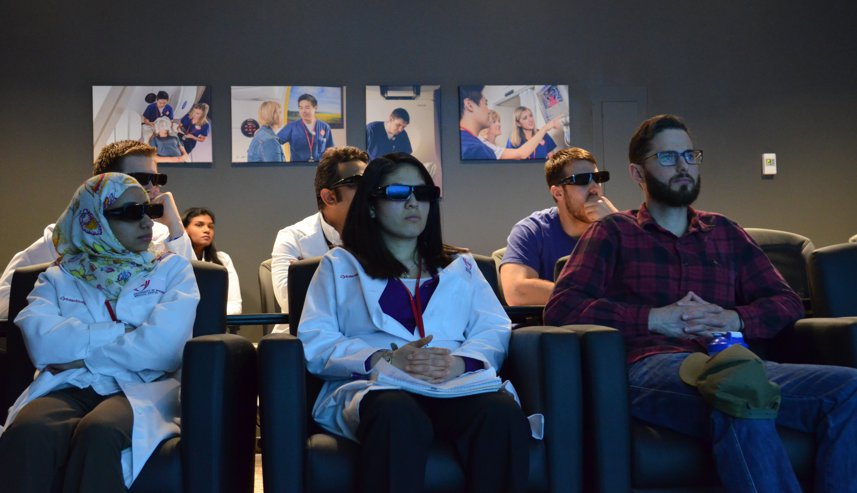For an instant, a UNMC radiation therapy student, wearing special 3-D goggles, felt super powers while fully immersed in the VERT. It was mindboggling, she said.
The VERT, short for Virtual Environment Radiotherapy Training system, allows students to “see”- as if with 3-D, X-ray vision – internal organs being hit with rays of radiation and its effects, making for a powerful lesson on what really happens inside a body during radiation therapy, and the importance of putting the proper dose in the right place.
“This must be what Superman sees.”
Yes, health care education is changing.
The age-old teaching mantra ‘See one, Do one, Teach one’ is being replaced with simulators, holograms and digital learning walls that allow students to hone their skills in risk-free environments.
Tomorrow’s health professions students will step inside a virtual heart, explore a three-dimensional lung, work in simulated clinical settings and, perhaps even learn from faculty members transported virtually from another site.
UNMC leaders are moving ahead with the Interprofessional Experiential Center for Enduring Learning, also known as iEXCEL℠, a bold initiative that will transform health care education. Through iEXCEL℠, learners will acquire knowledge, and learn and practice professional skills before encountering real-life patient care situations.
“This is a unique opportunity for UNMC and Nebraska to be a world leader in using near ‘real life virtual reality scenarios’ to transform performance in career-long health care education and training,” said UNMC Chancellor Jeffrey P. Gold, M.D.
“What aviation simulation did for the flight industry, iEXCEL℠ will do for health care education.”

Bradley Britigan, M.D.
This visionary project “has the potential to transform how we teach,” said Dele Davies, M.D., vice chancellor for academic affairs at UNMC. “We know that simulated settings accelerate learning and lead to high levels of mastery and retention of knowledge and technical skills, particularly among millennial learners.
“Our world is constantly changing around us and only the learners survive,” he said. “Millennial learners were born with the Internet attached to their hip.”
UNMC, Dr. Davies said, has the opportunity to be a leader in educational innovation, including the creation of educational courses that might allow trainees to ‘fly’ through the human heart, or see real patient imagery in 3-D in order to ‘rehearse’ surgical procedures prior to actual operations.
“The effective use of technology to teach has become a necessity to meet the needs of the digitally-native millennial and post-millennial students,” he said.
It also emphasizes active participation, the importance of which Abraham Flexner recognized in his 1910 Report of medical education, when he wrote:
“Each day students were subjected to interminable lectures and recitations. three or four or even five lectures delivered in methodical fashion . they observed more than participated.”
“What aviation simulation did for the flight industry, iEXCEL℠ will do for health care education.”
UNMC Chancellor Jeffrey P. Gold, M.D.
Long before that, an oft-attributed Ben Franklin quote, which arguably originated earlier from the works of Chinese philosopher Xun Kuang states: “Tell me and I forget. Teach me and I remember. Involve me and I learn.”
So true, Dr. Davies said, noting reports that learners remember 90 percent of what they do, as opposed to 10, 20 or 30 percent of what is respectively read, heard or seen.
At the heart of iEXCEL℠ is the planned Global Center for Advanced Interprofessional Learning, a cutting-edge training facility at UNMC that will house a variety of spaces in which learners are immersed in simulated and virtual, life-like scenarios (see story, page 11). These scenarios will enable health professions students to practice individual and team skills, as well as test their skill development, without putting them or their patients at risk.
The ideas behind iEXCEL℠ reach well beyond the actual building, however. iEXCEL℠ will be adopted across all UNMC campuses and offer new ways of teaching students – at all levels of training and in all health care disciplines – through interactive discussions, “flipped” classrooms, simulated activities and team-based training.
These new teaching methods are being employed and supported by the UNMC Interprofessional Academy of Teachers. iEXCEL℠ also will enable practicing providers (including military personnel) across Nebraska and around the world to master and upgrade their clinical care skills, as well as introduce and inspire health careers among elementary/secondary students.
Technology deployed across Nebraska’s communities will allow the center to be a resource for the entire state and beyond. Mobile, high fidelity simulation units will supplement simulation centers in Kearney, Norfolk and Lincoln and help bolster continuing education, as well as maintenance of certification, through statewide training opportunities.
The overall goal? To provide better health and better care for Nebraska through improved training outcomes.
